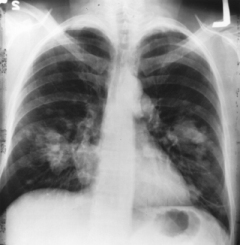 People with a history of smoking have a high risk of lung cancer – a disease with a five-year relative survival rate (for smokers and non-smokers combined) of only 15.8 percent. Previous attempts at developing a test to find lung cancer early, when it is easier to treat, have not been able to demonstrate a decrease in mortality rates. Now, a study sponsored by the National Cancer Institute (NCI) has determined that low-dose helical computed tomography (CT) scans can reduce lung cancer mortality for current and former heavy smokers. In the nation-wide study, which included over 53,000 participants, researchers found 20 percent fewer lung cancer deaths among those who were screened with low-dose helical CT (also known as spiral CT) compared with those who were screened withchest X-rays. In addition, deaths from all-causes (including lung cancer) were seven percent lower in those who received the low-dose helical CT scans.
People with a history of smoking have a high risk of lung cancer – a disease with a five-year relative survival rate (for smokers and non-smokers combined) of only 15.8 percent. Previous attempts at developing a test to find lung cancer early, when it is easier to treat, have not been able to demonstrate a decrease in mortality rates. Now, a study sponsored by the National Cancer Institute (NCI) has determined that low-dose helical computed tomography (CT) scans can reduce lung cancer mortality for current and former heavy smokers. In the nation-wide study, which included over 53,000 participants, researchers found 20 percent fewer lung cancer deaths among those who were screened with low-dose helical CT (also known as spiral CT) compared with those who were screened withchest X-rays. In addition, deaths from all-causes (including lung cancer) were seven percent lower in those who received the low-dose helical CT scans.


